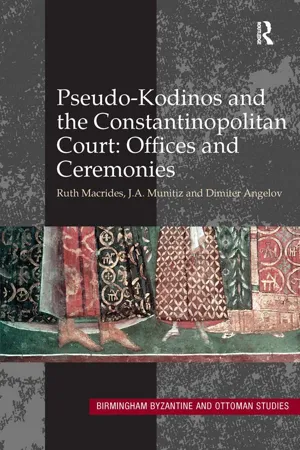
Pseudo-Kodinos and the Constantinopolitan Court: Offices and Ceremonies
- 578 pages
- English
- ePUB (mobile friendly)
- Available on iOS & Android
Pseudo-Kodinos and the Constantinopolitan Court: Offices and Ceremonies
About This Book
The work known as Pseudo-Kodinos, the fourteenth-century text which is one of two surviving ceremonial books from the Byzantine empire, is presented here for the first time in English translation. With facing page Greek text and the first in-depth analysis in the form of commentary and individual studies on the hierarchy, the ceremonies, court attire, the Blachernai palace, lighting, music, gestures and postures, this volume makes an important new contribution to the study of the Byzantine court, and to the history and culture of Byzantium more broadly. The unique traits of this ceremony book include the combination of hierarchical lists of court officials with protocols of ceremonies; a detailed description of the clothing used at court, in particular, hats and staffs; an account of the functions of the court title holders, a description of the ceremonies of the year which take place both inside the palace and outside; the service of the megas domestikos in the army, protocols for the coronation of the emperor, the promotions of despot, sebastokrator and caesar, of the patriarch; a description of the mourning attire of the emperor; protocol for the reception of a foreign bride in Constantinople all these are analysed here. Developments in ceremonial since the tenth-century Book of Ceremonies are discussed, as is the space in which ceremonial was performed, along with a new interpretation of the 'other palace', the Blachernai. The text reveals the anonymous authors' interest in the past, in the origins of practices and items of clothing, but it is argued that Pseudo-Kodinos presents descriptions of actual practice at the Byzantine court, rather than prescriptions.
Frequently asked questions
Information
Index
- Abbasid caliph 73
- Abbasid court 391, 474
- abbots 189, 259, 337, 451
- staff of 337
- abiotikon 209
- acclamations 11, 125, 145, 147, 163, 175, 185, 187, 201 ,227, 253, 255, 379, 382, 386, 402, 403, 404, 408, 409, 420, 422, 425, 426, 436, 439, 440, 442, 445; see also polychronion
- Acropolis (of Constantinople) viii, 11, 109, 199, 267, 437
- acropolis (at Trebizond) 372
- Adam Usk, chronicler 345
- adnoumion, -ia 107, 207; see also megas admoumiastes
- adolescent(s) 41, 81, 317, 324
- Adoration of the Cross, feast of the 169, 171, 191, 381
- Adrianople 267, 390
- adventus 412, 437
- aer 41; see also brim
- Aetios, cistern of 199
- Agathangelos, see Angelos, Manuel
- Agnes of France, daughter of king Louis VII 47, 147, 337, 358, 365, 406
- agora 382
- akakia plates 1, 2, 14, 18, 139, 141, 143, 145, 171, 347, 348, 364, 402, 411, 452; see also anexikakia
- Akathistos 179
- akolouthos 31, 65, 109, 282, 301, 398, 466; see also chourtzes
- Akropolites, Constantine, megas logothetes 51, 286, 309, 332, 333, 357, 397
- Akropolites, George 9, 326, 362, 380, 388, 412
- Alans 8, 209
- Al...
Table of contents
- Cover
- Half Title
- Title Page
- Copyright Page
- Dedication
- Table of Contents
- List of Plates
- List of Tables, Maps, Plans
- List of Abbreviations
- A Note on Transliteration and Citation
- Preface and Acknowledgements
- Introduction
- The Text, Translation and Commentary
- Studies
- Appendix (Tables III, IV, V)
- Bibliography
- Index